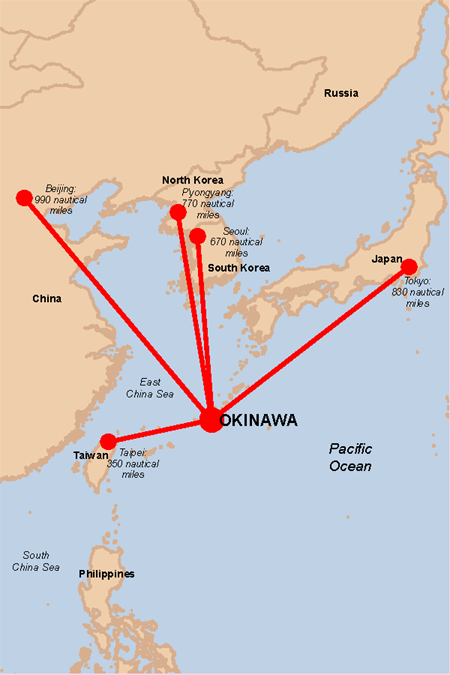CRS: The U.S. Military Presence in
Okinawa and the Futenma Base Controversy. / : Emma
Chanlett-Avery ; Ian E. Rinehart. 2012 ;
2016. 
'The relocation of Marine Corps Air Station Futenma (MCAS Futenma)
is the largest and most problematic part of a broad overhaul of the
stationing of U.S. forces in Japan and changes in how the Japanese
and American militaries operate. A 2006 agreement between the U.S.
and Japanese governments to relocate the Futenma base from its
current location in the crowded city of Ginowan to Camp Schwab in
Henoko, a less congested part of the island, was envisioned as the
centerpiece of a planned realignment of U.S. forces in Japan. The
proposed air station is often referred to as the Futenma
Replacement Facility (FRF). The arrangement was designed to reduce
the local community’s burden of hosting a loud air base that
has generated safety concerns and, eventually, to return control of
the Futenma land to local authorities as a way to boost economic
development in the area. In addition, the relocation would have
triggered the transfer of roughly 8,000 marines and their
dependents from Japan to new facilities in Guam. Japan agreed to
pay around 60% of the $10.3 billion estimated costs.'
Jon Mitchell, "Agent Orange on Okinawa - The Smoking Gun:
U.S. army report, photographs show 25,000 barrels on island in
early ‘70s," The Asia-Pacific Journal, Vol 10, Issue 40, No.
2, October 1, 2012.
'During the Vietnam War, 25,000 barrels of Agent Orange were stored
on Okinawa, according to a recently uncovered U.S. army report.1
The barrels, containing over 1.4 million gallons (5.2 million
liters) of the toxic defoliant, had been brought to Okinawa from
Vietnam before being taken to Johnston Island in the Pacific Ocean
where the US military incinerated its stocks of Agent Orange in
1977.'
Jon Mitchell teaches at Tokyo Institute of Technology and is an
Asia-Pacific Journal associate. In September 2012,
“Defoliated Island”, a TV documentary based upon his
research, was awarded a commendation for excellence by
Japan’s National Association of Commercial Broadcasters. An
English version of the program is currently in production in order
to assist U.S. veterans exposed to military defoliants on
Okinawa.
The National Security Archive : Revelations in Newly Released
Documents about U.S. Nuclear Weapons and Okinawa, may 14,
1997.
(1) Memorandum, Ambassador Brown to Secretary Rogers, 4/29/69,
Subject: NSC Meeting April 30 - Policy Toward Japan: Briefing
Memorandum (Secret), with attached -
(2) Memorandum, Davis to Office of the Vice President, etc.,
4/29/69, Subject: U.S.-Japanese Relationship: Summary (Top Secret),
with attached
(3) NSSM 5 - Japan, Table of Contents and Part III: Okinawa
Reversion (Secret)
(4) NSDM 13: Policy Toward Japan, 5/28/69
(5) Memorandum of Conversation, Nixon/Sato, 11/19/69 (Top
Secret/Sensitive)
Documents 1-3 were originally marked by State Department reviewers
as to remain secret "until expiration of the U.S.-Japan Security
Treaty." These documents provide a detailed discussion of the
issues surrounding U.S. nuclear weapons in Okinawa and their fate
following reversion, and makes recommendations as to the position
the U.S. government should take in negotiations with Japan on this
issue. Page 2 of the first document and pages 2-3 of the second one
provide an overview of the issues, based on the more detailed
discussion found in the attached NSSM 5 extract. This extract can
only be found in one place, an obscure State Department record
collection which Dr. Wampler discovered at the U.S. National
Archives. The National Security Council had previously denied
release of the material found in document No. 3, including even the
descriptive information found on the table of contents. Dr. Wampler
noted that Document No. 3 contains "a detailed discussion of U.S.
military rights and interests regarding nuclear weapons on Okinawa,
in terms of nuclear storage and freedom for nuclear operations in
the Pacific and Asia. Until now, both Washington and Tokyo have
maintained a veil of secrecy wrapped in refusals to comment on
these subjects." (see pages 21-26 of Document No. 3) Of especial
importance, Dr. Wampler notes, is the statement on page 25 under
'(4) Only Transit Rights for Nuclear Armed Planes and Ships':
"Japan now acquiesces in transit by naval vessels armed with
nuclear weapons. This right would automatically extend to Okinawa.
(This is sensitive and closely held information)." [emphasis
added]. '
National Archives and Records Administration: Okinawa: Bastion
in the Pacific / Department of Defense. Department of the Army.
Office of the Deputy Chief of Staff for Operations. U.S. Army
Audiovisual Center.
- http://www.archive.org/details/gov.archives.111-tv-423
National Archives and Records Administration: Assault on
Okinawa [ETC.] Series: Motion Picture Films from "United News"
Newsreels, compiled 1942 - 1945. Part 1, British and U.S.
carrier-based planes bomb Okinawa...
- http://www.archive.org/details/gov.archives.arc.39056
Security in northeast Asia : from Okinawa to the DMZ :
hearing before the Subcommittee on Asia and the Pacific, Committee
on International Relations, House of Representatives, One Hundred
Fourth Congress, second session, April 17, 1996 (1996).
- http://www.archive.org/details/securityinnorthe00unit






